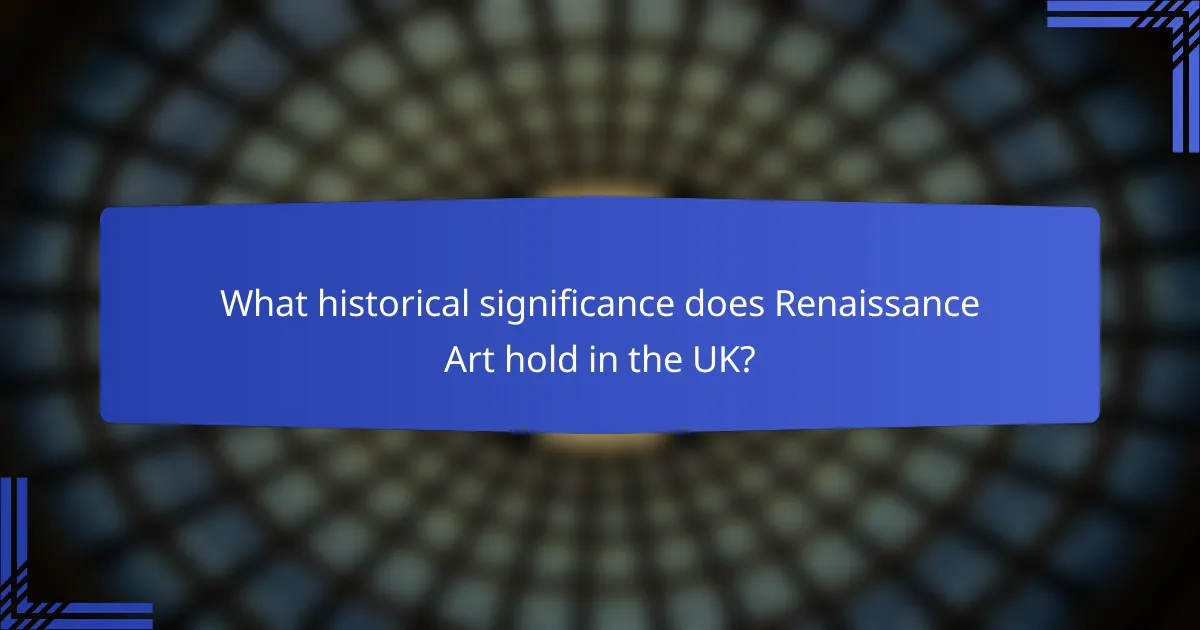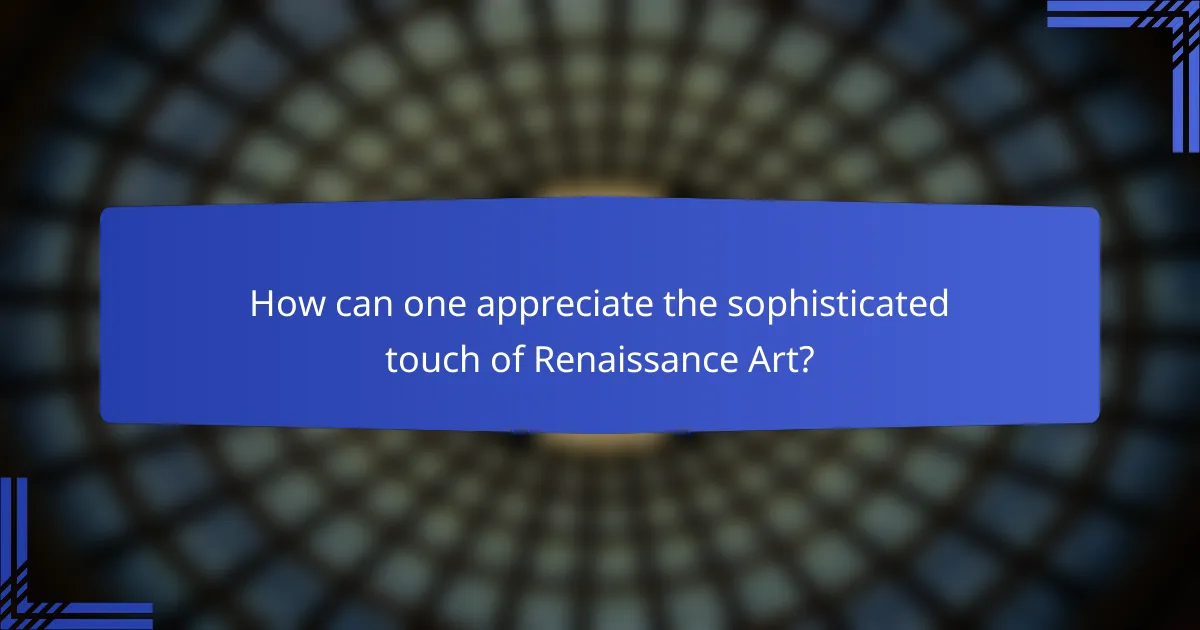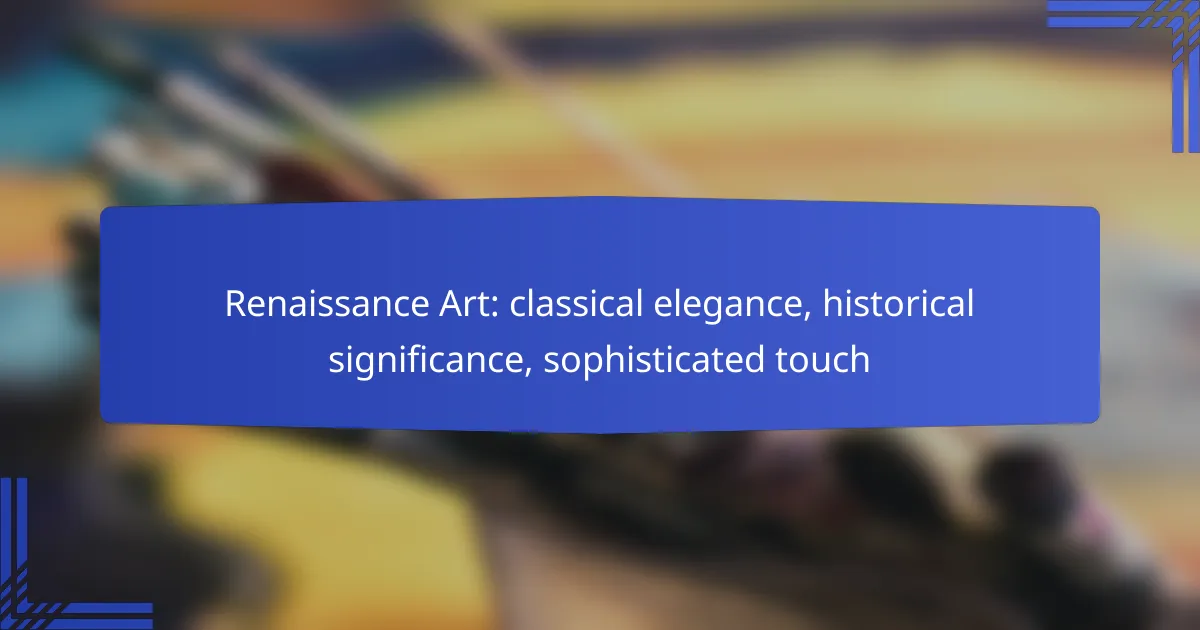Renaissance art is a celebration of classical elegance, characterized by its harmonious balance and beauty, rooted in the aesthetics of ancient Greece and Rome. This transformative period not only bridged the medieval and modern worlds but also introduced innovative techniques and perspectives that reshaped artistic expression. By exploring the intricate methods and emotional depth of this era, one can gain a profound appreciation for its historical significance and lasting impact on the art world.

How does Renaissance Art reflect classical elegance?
Renaissance art embodies classical elegance through its emphasis on harmony, balance, and beauty, drawing inspiration from ancient Greek and Roman aesthetics. This period marked a revival of classical ideals, resulting in artworks that showcase refined techniques and a deep appreciation for human form and nature.
Use of symmetry and proportion
Symmetry and proportion are fundamental principles in Renaissance art, reflecting the belief that beauty lies in balance. Artists like Leonardo da Vinci and Michelangelo employed mathematical ratios to create harmonious compositions, ensuring that each element of their work complemented the others. This approach not only enhanced visual appeal but also conveyed a sense of order and stability.
For example, the use of the golden ratio in paintings and sculptures helped artists achieve a pleasing aesthetic that resonated with viewers. When analyzing Renaissance works, look for these proportional relationships, as they are key indicators of classical elegance.
Incorporation of classical themes
Renaissance artists frequently incorporated classical themes, such as mythology, humanism, and the celebration of the human experience. These themes were often depicted through allegorical figures and narratives that connected contemporary society with ancient traditions. This blend of old and new allowed artists to explore complex ideas while maintaining a connection to their cultural heritage.
Notable examples include Botticelli’s “The Birth of Venus,” which illustrates classical mythology, and Raphael’s “School of Athens,” showcasing philosophers from antiquity. Such works highlight the Renaissance commitment to reviving and reinterpreting classical stories and ideals.
Influence of ancient Greek and Roman art
The influence of ancient Greek and Roman art is evident in the techniques and styles adopted by Renaissance artists. Sculptors and painters sought to emulate the realism and anatomical precision found in classical works, leading to a renewed focus on the human figure. This revival resulted in more lifelike representations, as seen in Michelangelo’s sculptures and Raphael’s portraits.
Additionally, architectural elements from ancient Rome, such as columns and domes, were integrated into Renaissance buildings, further emphasizing the connection to classical antiquity. When studying Renaissance art, consider how these ancient influences shaped the artistic landscape and contributed to its enduring legacy.

What historical significance does Renaissance Art hold in the UK?
Renaissance Art is significant in the UK as it marked a transformative period that bridged the medieval and modern worlds, influencing cultural, intellectual, and artistic developments. This era introduced new techniques and perspectives that reshaped the way art was created and appreciated, laying the groundwork for future artistic movements.
Revival of humanism in art
The revival of humanism during the Renaissance emphasized the value of human experience and individualism, which was reflected in the art of the time. Artists began to focus on realistic portrayals of the human form, emotions, and everyday life, moving away from the religious themes that dominated medieval art. This shift allowed for a more personal connection between the viewer and the artwork.
In the UK, this humanistic approach led to the creation of art that celebrated human achievement and the beauty of nature, influencing artists to explore new subjects and techniques. The incorporation of classical themes and styles from ancient Greece and Rome further enriched this artistic revival.
Impact on subsequent art movements
The innovations of Renaissance Art laid the foundation for various subsequent art movements, including Baroque, Neoclassicism, and Romanticism. Each of these movements drew inspiration from the techniques and themes established during the Renaissance, such as perspective, chiaroscuro, and the emphasis on human emotion.
In the UK, the influence of Renaissance Art can be seen in the works of later artists who adopted and adapted these principles, creating a rich tapestry of artistic expression that continued to evolve over centuries. The legacy of this period remains evident in contemporary art practices as well.
Key figures like Leonardo da Vinci and Michelangelo
Leonardo da Vinci and Michelangelo are two of the most celebrated figures of the Renaissance, known for their groundbreaking contributions to art and science. Da Vinci’s mastery of anatomy and perspective is evident in works like the “Mona Lisa” and “The Last Supper,” which showcase his innovative techniques and deep understanding of human emotion.
Michelangelo, renowned for his sculptural prowess and painting, created iconic works such as the “David” and the Sistine Chapel ceiling. His ability to convey the human form with dramatic intensity and detail has had a lasting impact on the art world. Both artists exemplified the ideals of the Renaissance, blending art with intellectual inquiry and setting standards that continue to inspire artists today.

How can one appreciate the sophisticated touch of Renaissance Art?
To appreciate the sophisticated touch of Renaissance Art, focus on the intricate techniques and emotional expressions that define this period. Understanding the methods artists used can deepen your appreciation for their work and the historical context in which it was created.
Understanding techniques like chiaroscuro
Chiaroscuro is a technique that uses strong contrasts between light and dark to create a sense of volume and depth in painting. This method enhances the three-dimensionality of figures, making them appear more lifelike. Artists like Caravaggio and Leonardo da Vinci mastered this technique, using it to draw attention to focal points in their compositions.
When observing a painting, notice how light falls on different surfaces and how shadows are used to define shapes. This interplay can evoke mood and drama, making the artwork more engaging. Look for these contrasts in works such as “The Last Supper” or “The Calling of Saint Matthew.”
Exploring the use of oil paints
The introduction of oil paints during the Renaissance allowed artists to achieve greater detail and richer colors than ever before. This medium dries slowly, giving painters the flexibility to blend colors and create subtle gradations. Notable artists like Titian and Rembrandt utilized oil paints to enhance texture and luminosity in their works.
When examining oil paintings, pay attention to the layering techniques used. Artists often applied multiple thin layers of paint, known as glazes, to build depth and complexity. This method can be seen in the vibrant colors of “Venus of Urbino” by Titian, where the skin tones appear almost radiant.
Analyzing the emotional depth in portraits
Renaissance portraits often convey profound emotional depth, capturing the personality and status of the subject. Artists employed techniques such as direct gaze and subtle facial expressions to engage viewers and evoke empathy. Portraits by artists like Raphael and Jan van Eyck exemplify this emotional connection.
When viewing a portrait, consider the subject’s expression, posture, and the details in their clothing. These elements can reveal insights into their character and social standing. For instance, the meticulous detail in the attire of “The Arnolfini Portrait” suggests wealth and status, while the subject’s gaze invites personal reflection.

What are the key characteristics of Renaissance Art?
Renaissance Art is marked by its emphasis on realism, naturalism, and a revival of classical themes. Artists of this period sought to depict the human experience with accuracy and emotional depth, reflecting a shift towards individualism and humanism.
Realism and naturalism
Realism and naturalism are fundamental characteristics of Renaissance Art, focusing on accurate depictions of the human form and the natural world. Artists studied anatomy and used live models to create lifelike representations, moving away from the stylized forms of medieval art.
Notable examples include Leonardo da Vinci’s “Vitruvian Man,” which illustrates the ideal human proportions, and Michelangelo’s sculptures, which showcase detailed muscle structure and movement. This attention to detail helped convey emotion and narrative in their works.
Perspective and depth
Perspective and depth were revolutionary techniques in Renaissance Art that allowed artists to create a three-dimensional illusion on a two-dimensional surface. Linear perspective, developed by artists like Filippo Brunelleschi, uses converging lines to draw the viewer’s eye into the depth of the scene.
For instance, in Raphael’s “The School of Athens,” the use of perspective not only enhances spatial depth but also emphasizes the importance of the figures depicted. Artists often employed atmospheric perspective, where colors and clarity fade with distance, further enhancing realism.
Religious and mythological themes
Religious and mythological themes are prevalent in Renaissance Art, reflecting the era’s fascination with classical antiquity and spirituality. Many works depict biblical scenes, saints, and mythological figures, often infused with humanist ideals that highlight the human experience.
Famous examples include Michelangelo’s “The Creation of Adam” on the Sistine Chapel ceiling, which combines divine themes with human emotion. Additionally, Botticelli’s “The Birth of Venus” merges mythology with beauty, showcasing the era’s appreciation for both religious and classical narratives.

What are the prerequisites for studying Renaissance Art?
To study Renaissance Art effectively, a foundational understanding of art history and key artists is essential. These prerequisites provide context and depth, enabling a richer appreciation of the period’s classical elegance and historical significance.
Familiarity with art history
A solid grasp of art history is crucial for studying Renaissance Art, as it situates the movement within broader artistic trends and developments. Understanding prior periods, such as the Gothic and Classical eras, helps to appreciate the innovations and stylistic shifts that characterize the Renaissance.
Key concepts, such as perspective, composition, and the use of color, emerged during this time. Familiarity with these elements allows for a more nuanced analysis of Renaissance works and their impact on subsequent art movements.
Knowledge of key artists and their works
Recognizing influential artists and their masterpieces is vital for anyone studying Renaissance Art. Artists like Leonardo da Vinci, Michelangelo, and Raphael not only defined the era but also set standards for artistic excellence that resonate today.
Familiarity with iconic works, such as the “Mona Lisa,” “David,” and “The School of Athens,” provides insight into the themes and techniques that were prevalent during the Renaissance. Engaging with these pieces can enhance understanding and appreciation of the artistic innovations of the time.
